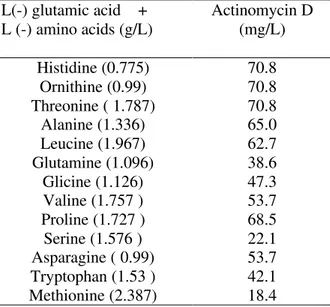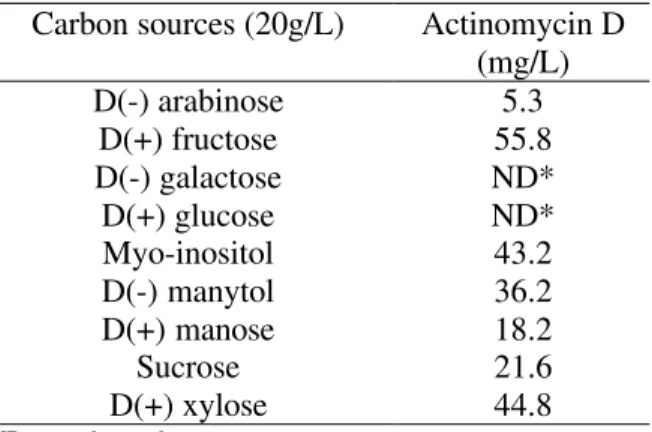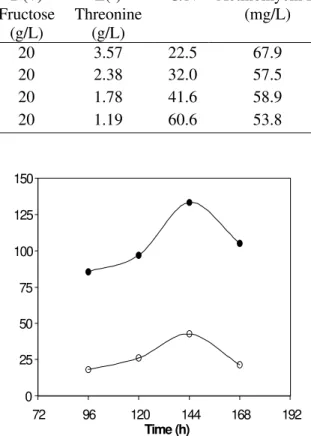Vol. 44, N. 3 : pp. 227 – 231, September, 2001
ISSN 1516-8913 Printed in Brazil
BRAZILIAN ARCHIVES OF
BIOLOGY AND TECHNOLOGY
A N I N T E R N A T I O N A L J O U R N A L
A Chemically Defined Medium for Production of
Actinomycin D by
Streptomyces parvulus
Maria de Fátima Vieira de Queiroz Sousa
1*, Carlos Edison Lopes
1and Nei Pereira Júnior
21Departmento de Antibióticos, Centro de Ciências Biológicas da Universidade Federal de Pernambuco, Recife,
50670-901, Pernambuco, 2Departamento de Engenharia Bioquímica, Escola de Química da Universidade Federal do Rio de Janeiro, Rio de Janeiro 21949-900, Brasil
ABSTRACT
A chemically defined medium consisting of D(+)fructose, L(-)threonine, K2HPO4, MgSO4.7H2O, ZnSO4.7H2O,
CaCl2.2H2O, FeSO4.7H2O and deionized water, was developed to maximize the synthesis of actinomycin D by the
Streptomyces parvulus DAUFPE 3124 strain. This medium resulted in the maximum antibiotic concentration of 133mg/L while using the original medium the production of actinomycin D was poor not surpassing 43mg/L.
Key words : Actinomycin D, production, Streptomyces. parvulus, synthetic medium
*
Author for correspondence
INTRODUCTION
The actinomycins are a family of chromopeptide antibiotics that present antitumoral properties, being employed in the treatment of several human neoplasies (Waksman & Furness, 1960). Structurally, they have a chromophorous group, identical in all actinomycins, and two pentapeptide chains with a variable composition of amino acids (Brockmann, 1960). They are synthesized by
Streptomyces as mixtures of different actinomycins, however, the S. parvulus species produces actinomycin D almost exclusively (>95%) (Meienhofer & Atherton, 1973). Over the last ten years, research into actinomycin D has been directed mainly towards clinical applications and no work related to production was found. In a previous study the authors optimized a complex medium for the production of actinomycin D by S. parvulus DAUFPE 3124 strain, increasing the final antibiotic concentration from 245 mg/L to 530 mg/L (Sousa, et al., 1997). Few papers have been found that focus on the nutritional requirements of Streptomyces species for
achieving a high actinomycin yield (Katz et al.,1958; Williams & Katz, 1977). Katz et al.
3124 strain. This work presents a set of experiments that culminated in the development of a chemically defined medium in which higher concentration of actinomycin D was achieved using the S. parvulusDAUFPE 3124 strain.
MATERIALS AND METHODS
Microorganism: Streptomyces parvulus DAUFPE 3124 strain was used in all assays. This strain was maintained on slants of 4 g/L glucose, 4 g/L yeast extract and 10 g/L malt extract agar medium. Incubation was carried out for 3 to 5 days at 30°C until gray spores developed and the slants were stored at 4°C.
Preparation of Spore Suspension: The spores were scraped from the surface of heavily sporulated slants with 3 ml of 9 g/L NaCl solution containing 1 ml/L of Tween 80, following the Hopwood et al., (1985) technique. The spore concentration was quantified in the suspension and stored in the freezer at -4°C.
Growth and Production Media: The medium
used during the biomass growth had the following composition: 5 g/L tryptone and 3 g/L yeast extract. In the antibiotic production several media were used with pH adjusted to 7.0 and in all of them, the following basal mineral salts medium K2HPO4 1.0 g/L; MgSO4.7H2O 25 mg/L; ZnSO4.7H2O 25 mg/L; CaCl2.2H2O 25 mg/L; FeSO4.7H2O 25 mg/L was used. A number of amino acids and carbohydrates were tested as carbon and nitrogen sources so that the C/N ratio was held around 41.7, as recommended by Williams & Katz (1977), and several C/N ratios were employed when the best carbon and nitrogen sources were selected. The amino acids, carbohydrates and salts were sterilized separately and added just prior to inoculation.
Experimental Procedure: The growth was
performed in two steps. In the first one, the inoculum was prepared in a 250 ml flask containing 25 ml of growth medium inoculated with 50 µl of spore suspension (8.0 x 107 cfu/ml).The flasks were placed on a rotary shaker at 250 rpm at 30ºC for 48 h. In the second step, 20 ml of the mycelial suspension was used to inoculate a 2000 ml flask containing 200 ml of
growth medium which was subjected to the same conditions as described above for 24 h. The antibiotic production was conducted in 500 ml shaken flasks, containing 50 ml of the fermentation medium. These flasks were inoculated with 3 ml of mycelial suspensions and subjected to the same conditions as cited above. Samples were taken at 24 hour intervals and analysed in terms of actinomycin D concentration by spectrophotometric method (Katz & Weissbach, 1963). The data reported in all experiments represent the yield of actinomycin D for 144 hours of cultivation except for the last one.
RESULTS AND DISCUSSION
As observed by Williams & Katz (1977), the association of L(-)glutamic acid with another amino acid potentialized the synthesis of actinomycin D by S. parvulus ATCC 12434. This fact was tested using the S. parvulus DAUFPE 3124 and the results are shown in the Table 1. This table shows that a maximum concentration of actinomycin D was obtained when the L(-) glutamic acid was combined with L(-)histidine, L(-)ornithine or L(-)threonine (70.8 mg/L).
Table 1 - Effect of L(-) amino acids provided in combination with L(-) glutamic acid for actinomycin production by S. parvulus DAUFPE 3124 grown in a 40 g/L D(+) fructose, 2.2 g/L L(-) glutamic acid basal mineral salts medium for 144 h at 30ºC (C/N ratios between 41.2 and 42.8).
L(-) glutamic acid + L (-) amino acids (g/L)
Actinomycin D (mg/L)
Histidine (0.775) 70.8
Ornithine (0.99) 70.8
Threonine ( 1.787) 70.8
Alanine (1.336) 65.0
Leucine (1.967) 62.7
Glutamine (1.096) 38.6
Glicine (1.126) 47.3
Valine (1.757 ) 53.7
Proline (1.727 ) 68.5
Serine (1.576 ) 22.1
Asparagine ( 0.99) 53.7
Tryptophan (1.53 ) 42.1
Methionine (2.387) 18.4
appropriated for antibiotic synthesis (Table 2). The best result (87.7 mg/L) was achieved when L(-) threonine was the sole nitrogen source. Surprisingly, this result was higher than the one obtained (70.8 mg/L) by the combination of L(-) glutamic acid and L(-) threonine. In the literature there is no explanation for this effect and, furthermore, it results in a cheaper chemically defined medium composition.
Table 2 - Effect of L(-) amino acids in actinomycin D production by S. parvulus DAUFPE 3124 grown in a 20 g/L D(+) fructose basal mineral salts medium for 144 h at 30ºC (C/N ratios between 38.9 and 43.3)
L(-) amino acids (g/L) Actinomycin D (mg/L)
Threonine (1.785) 87.7
Ornithine (0.99) 34.6
Histidine (0.775) 77.1
Alanine (0.445) 49.8
Leucine (1.96 ) 16.6
Glutamine (1.1) 70.2
Glicine (1.125) 82.0
Valine (1.75) 74.0
Proline (1.725) 77.1
Aspartic acid (1.1) 35.7
Asparagine (1.0 ) 84.5
Glutamic acid (2.2) 54.7
Methionine (2.2 ) 7.7
L(-) threonine is one of the amino acids constituents of the actinomycin molecules. Katz et al. (1965)employed labeled L(-) threonine - 14Cin experiments of short incubation and verified that
S. antibioticus strains metabolizes this amino acid in both protein and actinomycin synthesis. Due to this evidence, these authors came to the conclusion that there is an intracellular pool of threonine commom to the two synthesizer systems although these systems were differents.
A number of carbohydrates were investigated as carbon sources for actinomycin-D production employing the basal mineral salts medium with 1.8 g/L of threonine and the results can be seen in Table 3. This table shows that D(+) fructose was superior to the others carbohydrates tested in the same concentration. This result agrees with the findings of Williams & Katz (1977), who affirmed that D fructose was the most effective carbon source for antibiotic synthesis by S. parvulus. No actinomycin-D production was detected when glucose and galactose were employed as sole carbon sources. Gallo & Katz (1972) demonstrated
that glucose supports a rapid growth rate of S. antibioticus, but it exerts severe catabolite repression in antibiotic production, particulary in the synthesis of phenoxazinone synthase, an essential enzyme for the formation of the actinomycin chromophorous group. Williams & Katz (1977) working with S. parvulus ATCC 12434, also showed the repression caused by glucose additions to a chemically defined medium containing fructose (40g/L) as the main substrate. Marshall et al. (1968) verified the inhibitory effect of galactose on phenoxazinone synthetase specific activity in cells of
S. antibioticus harvested after six hours of incubation.
Table 3 - Influence of several carbon sources on actinomycin production by S. parvulus DAUFPE 3124 grown in a 1.8 g/L L(-) threonine basal mineral salts medium for 144 h at 30ºC (C/N=41.5)
Carbon sources (20g/L) Actinomycin D (mg/L)
D(-) arabinose 5.3
D(+) fructose 55.8
D(-) galactose ND*
D(+) glucose ND*
Myo-inositol 43.2
D(-) manytol 36.2
D(+) manose 18.2
Sucrose 21.6
D(+) xylose 44.8
*ND – not detected
To evaluate the quantitative influence of C/N ratios upon antibiotic synthesis by S. parvulus
DAUFPE 3124,the concentration ofD(+) fructose (20 g/L) was held constant while the amount of L(-) threonine was varied to provide different C/N ratios in the medium. The results of these experiments are shown in Table 4.
Higher production of actinomycin-D (67.9mg/L) was achieved at C/N ratio of 22.5 which corresponded to 20 g/L D(+) fructose and 3.57 g/L L(-) threonine.
Comparative study of the medium reported by Williams & Katz (1977) and the one developed in this work was done employing S. parvulus
Table 4 - Effect of several C/N ratios on actinomycin D production by S. parvulus DAUFPE 3124 grown in a basal mineral salts medium for 144 h at 30ºC.
D(+) Fructose
(g/L)
L(-) Threonine
(g/L)
C/N Actinomycin D (mg/L)
20 3.57 22.5 67.9
20 2.38 32.0 57.5
20 1.78 41.6 58.9
20 1.19 60.6 53.8
0 25 50 75 100 125 150
72 96 120 144 168 192
Time (h)
Figure 1 – Actinomycin D concentrations obtained in shaken flasks by S. parvulus DAUFPE 3124, using chemically defined media (¡)reported by Williams & Katz (1977) and (l) suggested by present work.
The results clearly show the dependence of the antibiotic synthesis on medium constituents. The medium developed in this study to obtain high yield of actinomycin D by S. parvulus DAUFPE 3124 has the following composition: 20 g/L D(+) fructose; 3.57 g/L L(-) threonine; 1.0 g/L K2HPO4; 25 mg/L MgSO4.7H2O, 25 mg/L ZnSO4.7H2O, 25
mg/L CaCl2.2H2O and
25 mg/L FeSO4.7H2O. This composition allowed an improvement of over 200 % in the concentration of actinomycin D.
ACKNOWLEDGMENTS
This work was supported in part by Fundação de Amparo à Ciência e Tecnologia do Estado de Pernambuco.
RESUMO
Um meio quimicamente definido composto de D (+) frutose, L (-) treonina, K2HPO4, MgSO4.7H2O, ZnSO4.7H2O, CaCl2.2H2O, FeSO4.7H2O e água deionizada, foi desenvolvido para maximizar a síntese de actinomicina D pelo
Streptomyces parvulus DAUFPE 3124. O meio proposto resultou numa concentração antibiótica máxima de 133 mg/L enquanto que no meio inicial a produção antibiótica foi baixa, não ultrapassando 43 mg/L.
REFERENCES
Brockmann, H. (1960), Structural differences of the actinomycins and their derivatives. Ann. N. Y. Acad. Sci. 89, 323-335
Dalili, M. and Chau, P. C. (1988), Production of actinomycin D with immobilized Streptomyces parvulus under nitrogen and carbon starvation conditions. Biotechnol. Lett. 10, 331-336
Gallo, M. and Katz, E. (1972), Regulation of secundary metabolite biosynthesis catabolic repression of phenoxazinone synthase and actinomycin formation by glucose. J. Bacteriol. 109, 659-667
Hopwood, D. A.; Bibb, M. J.; Chater, K. F.; Kieser, T.; Bruton, C. J.; Kieser, H. M.; Lydiate, D. J.; Smith, C. P.; Ward, J. M. and Schrempf, H. (1985), Genetic manipulation of Streptomyces: a laboratory manual. The John Innes Foundation, Norwich, 2-9
Katz, E.; Pienta, P. and Sivak, A. (1958), The role of nutrition in the synthesis of actinomycin. Appl. Microbiol.6, 236-241
Katz, E. and Weissbach, H. (1963), Incorporation of
14
C-labeled amino acids into actinomycin and protein by S. antibioticus. J. Biol. Chem. 238, 666-675 Katz, E.; Wise, M. and Weissbach, H. (1965),
Actinomycin Biosynthessis: differential effect of chloramphenicol on protein and peptide antibiotic synthesis. J. Biol. Chem. 240, 3071-3078
Marshall, R.; Redfield, B.; Katz, E. and Weissbach, H. (1968), Changes in phenoxazinone synthetase activity during the growth cycle of S. antibioticus. Arch. Biochem. Biophys. 123, 317-323
Meienhofer, J. and Atherton, E. (1973), Structure-activity relationship in the actinomycins. Adv. Appl. Microbiol.16, 203-300
Sousa, M. F. V. Q.; Lopes, C. E. and Pereira Jr., N. (1977), Medium optimization for the production of actinomycin-D by Streptomyces parvulus. Arq. Biol. Tecnol.40, 405-411
Waksman, S. A. and Furness, F. N. (1960), The actinomycins and their importance in the treatment of tumors in animals and man. Ann. N. Y. Acad. Sci., 89,
Williams, W. K. and Katz, E. (1977), Development of a chemically defined medium for the synthesis of actinomycin D by Streptomyces parvulus. Antimicrob. Agents Chemother, 11, 281-290


